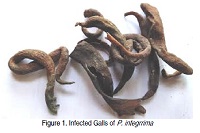Pistacia integrrima Stewart ex Brandis: a less known high value medicinal plant
Keywords:
Pistacia integrrima, kakar singi, indigenous uses, medicinal potentialAbstract
The family Anacardiacea, best represented by the species Pistacia integrrima Stewart ex Brandis, is known worldwide for its manifold uses. It is widely used to cure various diseases like cold, cough, asthma, fever, vomiting and diarrhea, etc., and widely used in modern medicine. Therefore, an attempt has been made to assess the medicinal potential of the species both in traditional as well as in modern medicine system. These properties are supposed to be cured by different active compounds present in the plant. This paper provides the relevant information about medicinal properties of this high value medicinal plant.
References
. Uddin G, Rauf A, Arfan M, Waliullah I, Khan M. Ali M, Taimur I, Rehman Ur, S. Pistagremic acid a new leishmanicidal triterpene isolated from Pistacia integerrima Stewart. Journal of Enzyme Inhibition and Medicinal Chemistry Enzyme. 2012; 27(5).
. AL-Saghir M. Porter D. Taxonomic Revision of the Genus Pistacia L. (Anacardiaceae). American Journal of Plant Sciences. 2012; (3): 12-32.
. Chopra RN, Nayar SL, Chopra IC. Glossary of Indian Medicinal Plants, Council of Scientific and Industrial Research, New Delhi. 1956; (67, 87, 170): 260-261.
. Ansari SH, Ali M, Qadry JS. Three new tetracyclic triterpenoids from galls of Pistacia integerrima Stew. Pharmazie. 1993; (48): 215–217.
. Hassan Amhamdi, Fatima Aouinti, Jean Paul Wathelet Ali Elbachiri. Chemical Composition of the Essential Oil of Pistacia lentiscus L. from Eastern Morocco. Records of Natural Products. 2009; 3 (2):90-95.
. Ansari SH, Ali M, Qadry JS, Siddiqui N. Analgesic activity of tetracyclic triterpenoids isolated from Pistacia integerrima galls. Update Ayurveda. 1994; (94): 73.
. Ansari SH, Ali M, and Qadry JS. New tetracyclic triterpenoids from Pistacia integerrima galls, Pharmazie, 1993; (9): 356-357.
. Ansari SH, Ali M. Analgesic and anti-inflammatory activity of tetracyclic triterpenoids isolated from Pistacia integerrima galls. Fitoterapia. 1996; (67): 103-105.
. Ahmad NS, Waheed A, Farman M, Qayyum A. Analgesic and anti-inflammatory effects of Pistacia integerrima extracts in mice. Journal of Ethnopharmacology. 2010; (129): 250-253.
. Ahmad NS, Farman M, Najmi MH, Mian KB, Hassan A. Pharmacological basis for use of Pistacia integerrima leaves in hyperuricemia and gout. Journal of Ethnopharmacol. 2008; (117): 478-482.
. Ansari SH, Ali M, Qadry JS. New tetracyclic triterpenoids from Pistacia integerrima galls. Pharmazie. 1994; (49): 356-357.
. Monaco PL, Mangoni L. Terpenes in Pistacia plants: a possible defence role for monoterpenes against gall-forming aphids. Phytochemistry. 1982; (21): 1408.
. Tabacik-Wlotzka C, Imbert JL, Pistre P. Isolation of polyisoprenols from the neutral extract of Pistacia terebinthus. C. R. Hebd. Sciences Acad. Sci., Ser. D. 265, 708 (Chem. Abst. 67( 32845d). 1967.
. Monaco PR, Caputo G, Mangoni L. Triterpene components of galls on the leaves of Pistacia terebinthus, produced by Pemphigus semilenarius. Phytochemistry. 1974; (13): 1992.
. Caputo R, Mangoni L, Monaco P, Palumbo G. Triterpenes from the galls of Pistacia palestina, Phytochemistry. 1979; (18): 896-898.
. Caputo R, Mangoni L. Triterpenic acids of Pistacia terebinthus galls. Gazzetta Chimica Italica. 1970; (100): 317-325.
. Hiroi T, Takahashi T, Imamura H. Wood extractives. XV. Constituents of Pistacia chinensis Wood, Nippon Mokuzai. Gakkaishi. 1966; (12): 324-326.
. Vickery JR. The occurrence of dihydromalavalic acid in some seed oils. Journal of the American Oil Chemist’s Society. 1981; (58): 731-732.
. Hiroi T, Takahashi T, Imamura H. Wood extractives. XV. Constituents of Pistacia chinensis Wood. Nippon Mokuzai, Gakkaishi. 1967; (12): 324-326.
. Kalidhar SH, Sharma P. Chemical components of Pistacia integerrima. Journal of the Indian Chemical Society. 1985; (62): 261.
. Pant S, Samant SS. Ethanobotanical observation in the Mornaula Reserve Forest of Kumoun, West Himalaya, India. Ethanobotanical Leaflets. 2010.
. Uddin G, Rauf A, Rehman TU, Qaisar M. Phytochemical Screening of Pistacia chinensis var integerrima. Middle-East Journal of Scientific Research. 2011; 7(5): 707-711.
. Padulosi S, Hodgkin T, Williams J, Haq N. Managing Plant Genetic Diversity. Wallingford: IPGRI/CABI Publishing. 2002; 323- 338.
. Kirthikar KR, Basu BD. Indian Medicinal Plants. Lalit Mohan Basu, Allahabad, India. 1935; Vol 2.
. Dev S. Ethanotherapeutics and modern drug development, the potential of Ayurveda. Current Science. 1997; 73 (11): 909-928.
. Nadkarni KM. Indian Materia Medica. 1976; 3rd Ed., Popular Prakashan.
. Rahman S, Ismail M, Muhammad N, Ali F, Chisthi AK, Imran M. Evaluation of the stem bark of Pistacia integerrima Stew ex Brandis for its antimicrobial and phytotoxic activities. Afr. J. Pharm. Pharmacol. 2011; 5(8): 1170-1174.
. Orwa C, Mutua A, Kindt R, Jamnadass R, Anthony S. Agroforestree Database: a tree reference and selection guide. 2009; version 4.0 (http://www.worldagroforestry.org/sites/treedbs/treedatabases.asp).
. Samant SS, Pant Shreekar, Singh Man, Lal Manohar, Singh Ashok, Sharma Aman, Bhandari Sakshi. Medicinal Plants in Himachal Pradesh, North Western Himalaya, India. International Journal of Biodiversity Science & Management. 2007; (3): 234-251.



